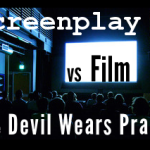We’re starting a new feature at Scribe Meets World. It’s called Box Office Blues. Catchy, no?
Basically, I’m going to examine movies that you’d think would do really well at the box office, but for some reason or other, tanked. By studying what went wrong in those movies, your own screenwriting skills should improve.
If you have a suggestion for the Box Office Blues series, please say so in the comments. To kick off this new feature, I’m going to analyze Something Borrowed, a romantic comedy which had a lot going for it.
It starred recognizable actors (Kate Hudson, John Krasinksi, Ginnifer Goodwin); it came with a built-in audience of all the fans of the 2005 bestselling novel it was based on…
…and it had an interesting premise: A consummate good girl, Rachel, has always allowed her best friend Darcy to take center stage…until her 30th birthday, when Rachel confesses her romantic feelings to Darcy’s fiance, Dex, and is both horrified and thrilled to discover he feels the same way.
Despite all of this, the movie, which was released in May of this year, only grossed $39 million dollars at the domestic box office (thanks Box Office Mojo!). While that number isn’t dismal, it’s not as high as it should be, especially when you consider how popular Emily Giffin’s novel was. Some would argue that the traditional rom-com is dead. But the success of The Proposal, The Holiday, It’s Complicated, and Valentine’s Day beg to differ.
The first time I saw Something Borrowed, I thought it was horrible. The second time I watched it, I thought it was pretty decent, most likely because I didn’t go in with ginormous expectations.
Being based on a beloved book is both a blessing and a curse. It’s a blessing because a lot of people will anticipate the movie’s release, but it’s a curse because those same people are going in with high expectations, which are difficult to live up to. (The Harry Potter and the Twilight franchises have done enormously well in this regard.)
When I saw Something Borrowed for the second time, my expectations were much lowered, and I found myself being mildly entertained. If you have patience, there is definitely the potential to amuse, especially the delightful Krasinski. His observation, “the Hamptons is a zombie movie directed by Ralph Lauren,” is one of my favorite comedic one-liners, and it is in its handling of romantic subplots where the movie really shines. The leads are a different story (more on that later).
While Rachel’s situation makes for an interesting premise, it’s also one which is morally tenuous. A lot of the target audience is going to have difficulty sympathizing for the woman who slept with her best friend’s fiance. The book was able to overcome this obstacle by sharing Rachel’s conflicting thoughts and emotions.
Giffin skillfully showed how Rachel didn’t emerge unscathed from what happened. This worked in the novel, where Giffin had the license to describe Rachel’s interior monologue. Since you can’t show thoughts on camera, screenwriters have a damned difficult time showing what’s going on in a character’s mind.
This is one of the greatest challenges for a screenwriter, and I do not envy Jennie Snyder, who wrote the adaptation. Besides the difficulty in conveying Rachel’s thoughts, there were other reasons why the movie didn’t strike a chord with its target audience. Here are a few of them. Hopefully studying these flaws will help you improve your own screenwriting skills.
No one likes a passive hero or heroine
Rachel is one of the most passive heroines I’ve ever seen in a romantic comedy. I realize that’s partly the point–her character arc involves transformation from Darcy’s passive doormat to an independent woman (cue up the Kelly Clarkson!).
But it’s tremendously tedious to watch. Midway through the movie, Rachel rhetorically asks Darcy, “do I ever say no to you?” No, Rachel, you don’t ever say no. You basically haven’t shown one iota of strength during the preceding 40 minutes.
Rachel’s love interest, Dex Thaler, isn’t any better. He’s also a weak, passive character, fortunately blessed with a great smile and a endless wardrobe from J Crew, and a penchant for mnemonic devices.
If you’re writing a romantic comedy, make sure that the audience has a reason to root for the two love interests to end up together. You know how everyone at Wimbledon was wondering who would win the epic match between Roger Federer and Rafael Nadal in 2008? That’s what it should be like for your audience.
They should be on tenderhooks, wondering if your leads will get together at the end. If we care about the characters, we’ll follow their journey, even if they start behaving like moronic teenagers on Spring Break when they reach the Hamptons.
But there really wasn’t a reason to root for Rachel, except out of pity. Sure, the girl has been living so long under Darcy’s shadow that she probably isn’t metabolizing enough vitamin D. Her self-confidence is wrecked. I get it. But in order for the audience to become interested in Rachel’s story, she had to demonstrate some spark of personality that we could relate too.
If we examine Notting Hill, Hugh Grant’s character isn’t overflowing with self-confidence. In fact, far from it, and yet we feel that he deserves a shot of happiness, and we watched to see that he got it (to the tune of $116 million, domestic). Most likely because Hugh Grant’s character was gracious, charming, and blessed with a self-deprecating sense of humor that made him fun to watch.
Flashbacks are a death sentence for your screenplay
There were multiple flashbacks in Something Borrowed; two were even within 2 and 1/2 minutes of each other. They did serve an important purpose: to show Rachel’s relationship with Dex in law school, and how there was a deep affection between the two well before Darcy ever entered into the picture.
This is vital information because it mitigates the immorality of Rachel coveting her best friend’s fiance. Of course, it’s still not right, but we can forgive Rachel, because after all, Dex was really hers first, even though they never had an explicitly romantic relationship.
But the presence of so many flashbacks broke up the flow of the story and really derailed the movie’s momentum. If flashbacks are essential to tell your story, first try to limit how many are present–and don’t sequence them right after the other.
Instead of peppering your screenplay with flashbacks, consider starting your script in the past, and showing all the relevant scenes from that period of your main character’s life. Then launch into the present day, and show all of your story events in chronological order. This technique worked in another romantic comedy, 13 Going on 30, as well as in the latest reboot of Star Trek.
I don’t recall the exact way Rachel and Dex’s relationship unfolded in Emily Giffin’s bestselling novel, but I do remember that the book did start with Rachel’s 30th birthday party, same as in the movie. That’s the tricky thing with adaptations. If you’re too faithful to the source material, you might not produce a product as engaging as the original.
I think it would have been better to have the movie start in the past than with Rachel’s 30th birthday party, if the screenplay was definitely going to include all the scenes from law school.
You might be wondering how Emily Giffin got away with all the flashbacks in her novel. For one thing, people seem to have a little more patience with a novel than with a movie.
More of a factor though is that Giffin’s novel benefited from being told in a compelling voice, which made readers root for Rachel, even though they don’t condone cheating with best friend’s fiances or otherwise.
We should care enough to send a Hallmark card
Rachel is devoted to Darcy to the point that she’s willing to sacrifice her own happiness for the sake of Darcy’s. When Darcy expressed qualms about getting married, Rachel could have easily told Darcy not to marry Dex. But, out of loyalty to her best friend, Rachel didn’t.
The problem though is that it’s almost impossible to see why. Rachel’s unwavering devotion to Darcy (except for that blip when she slept with Darcy’s fiance) seems so unwarranted in the face of Darcy’s endless narcissism and childishness.
At one point, Darcy, in a rather good imitation of a puppy obedience instructor, tells Rachel to “sit!” and of course, Rachel obliges. Rachel is already a passive character…for her to exhibit such poor judgment is just too much.
At the very beginning of the movie, in a great example of a “Save the Cat” moment, Darcy gives a speech at Rachel’s 30th birthday party. Although it’s Rachel’s birthday, Darcy wants the limelight. But despite hogging everyone’s attention, and making herself a key player in her toast to Rachel, it’s clear that she does have genuine affection for her best friend (however genuine a narcissist’s affection can be).
But Darcy’s actions during the rest of the movie undermine any goodwill the audience might have had for her–which calls into question Rachel’s loyalty…and Dex’s too. Dex is supposed to be this smart, attractive guy who can have his pick of talented, beautiful women. Sure, Darcy’s a babe, but she’s a child in a prom queen’s body.
Dex is supposed to have enough discernment to realize that. If he doesn’t, then what kind of choice is he for Rachel, who’s the heroine of this movie, albeit a passive one? If he has poor taste in women, then is he really a catch for Rachel?
The conflict and tension of the second act revolves around Rachel and Dex as they choose between their loyalty to Darcy and their own happiness. But if Darcy is a shrew, then there’s really no choice, is there? There’s really no reason for Rachel and Dex to be so torn.
By losing the very needy and unstable Darcy, they aren’t losing anything important–which means there are no stakes to their decisions, and the whole second act falls flat.
Now, if Darcy had demonstrated some likeable traits, and we could see why Rachel would want to be her friend and why Dex would want to be Darcy’s husband, then we’d have real tension and drama in the second act, as both Rachel and Dex stand to lose something precious.
In The Proposal, Sandra Bullock’s character, Margaret, was a major shrew, but she was darn good at her job. Her strength and ferocity were reasons why someone could hate her…but also reasons why someone could fall in love with her too. The same applies to Julia Stiles’s character, Kat Stratford, in 10 Things I Hate About You.
She was modeled after the archetypal shrew, Shakespeare’s Katherina Minola. Despite her tough exterior, Kat was a good friend to Mandela and a good sister to Bianca, which made her a shrew we didn’t mind watching for 90 minutes. Darcy could be narcissistic hottie, but if there were to be any real stakes in the second act, she should have had some redeeming features which mitigated her self-centeredness.
Finish strong
Good movies usually have endings so strong, they make us want to watch the movie all over again, so we can re-experience our hero’s journey. Romantic comedies are no exception.
Bridget Jones ends with Mark Darcy buying Bridget a new diary, and with them kissing in the snow. Notting Hill ends with snapshots from Will and Anna’s married life. Although he looks skittish as he attends a movie premiere where every camera lens is zoomed in upon them, the final shot shows Will and Anna sitting contentedly on a bench in a garden they sneaked into on their first date. Now, let’s look at the ending of Something Borrowed, and see how it compares.
Rachel happens to run into Darcy, who claims that she’s happy. Really happy. After this encounter, Rachel meets Dex, and they walk down the sidewalk, holding hands. Not the most memorable of endings, but it does resolve the two major story lines of the movie. I can get on board with that.
But what I don’t understand is the sleeve of Dex’s dry-cleaned shirts which Rachel totes around with her in both scenes. Nothing says romance more than chemical solvent.
If you’re having trouble with your screenplay’s last scenes, here are a few tips: make sure you do resolve all of your story lines by the end of the movie. The best endings often “callback” to an important setting or line of dialogue found earlier on in the script. The really great writers also manage to encapsulate the movie’s theme in the final image, sometimes even changing our interpretation of the film.
Final thoughts
There are lots of screenwriting lessons you can learn by studying movies that didn’t fare so well at the box office. Something Borrowed drove home many screenplay concepts amateurs are prone to forget:
- your heroes need to be active characters
- flashbacks are like arsenic to your screenplay
- if the audience doesn’t care about your leading lad and lady, they won’t care if the two lovers end up together
- close the deal with a strong ending
- and…adaptations are hard
May your screenplay be a box office success!
Rings by ILoveButter





















Comments on this entry are closed.
I agree with you about protagonists being active characters. Another example to me is Indiana Jones and the Temple of Doom versus both the first and third films, Raiders of the Lost Ark and Indiana Jones and the Last Crusade.
In Raiders and Crusade, Jones is actively in pursuit of something while also trying to keep others from obtaining it. In Temple of Doom, he is what I call a pinball character – he doesn’t do things, so much as things are done to him – accidentally happening upon the quest zone (after jumping out of plane in a raft and falling from a 300-foot waterfall), and even as he enters the palace it isn’t until he’s attacked that he (and the audience) is aware that this must be the place. Every other complaint or preference seems to pale in the light of this fundamental flaw – as well as sequel/character inconsistency.
Hi FilmKiller!
I can’t tell you how much I DETEST Temple of Doom. There are a number of reasons for this…but I’m not sure I ever thought about it terms of whether Indiana Jones behaves like a passive or active character. I might have to *ugh* rewatch it just to do an analysis. On the other hand, Raiders and the Last Crusade (esp. Raiders) are two of the best commercial movies ever made. If your screenplay has even 20% of the awesomeness that is Raiders, you’d be in good shape.
I like the term “pinball character.” It is a perfect way to visualize whether or not your hero is active. Perhaps we should rename the movie to…Indiana Jones in the Pinball Machine of Doom?!
I totally DISAGREE with you!
Something Borrowed is a great movie!
I’ve read also the book and I think the movie is better.
One of the best romantic comedies ever!
Unfortunately not all good movies get the credit they deserve.
Hi Stella,
Thanks for visiting Scribe Meets World…where healthy debate is always welcome! I’ve watched Something Borrowed twice, and after the second time, I felt that it was better than I originally thought…but still, not as good as I had hoped it would be.
Regardless of our personal opinions of the movie, it didn’t do that well at the box office…which signals to me that it didn’t resonate with a large part of its intended audience. There are many reasons for that–sometimes good movies don’t do well simply because they were marketed wrong. But sometimes it’s the movie itself which is the issue. For the reasons I outlined in my post, I think that’s the case here.
If Something Borrosed had an active heroine, made Darcy more three-dimensional, decreased the flashbacks, and finished stronger…I honestly think it would have done better.
I appreciate the passion behind your comment though. May all scribes write with such conviction!